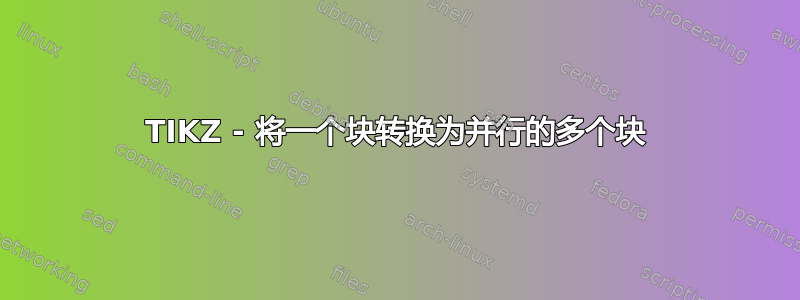
我有以下代码:
\documentclass[crop,tikz]{standalone}
\usepackage{tikz}
\usepackage{textcomp}
\usetikzlibrary{shapes,arrows}
\usetikzlibrary{positioning}
\usetikzlibrary{arrows,
chains,
decorations.markings,
shadows, shapes.arrows,shapes}
\begin{document}
\begin{tikzpicture}
\begin{scope}[start chain = going below,
every node/.append style={on chain,fill opacity=0.8,draw,
join},every join/.style={thick,-latex},
cs/.style={minimum width=4.5cm,copy shadow={shadow scale=1, shadow xshift=0.5ex, shadow yshift=-0.5ex}}
]
\node[fill=white] (N1) {\begin{tabular}{p{1cm}cp{1cm}}
IOH\\
& \enspace\tiny $K\times K$\quad\quad \quad &
\end{tabular}};
\node[fill=orange] (N2) {\begin{tabular}{p{4cm}cp{1cm}}
COI\\
\qquad\enspace\tiny\quad\quad\quad\quad $K\times K$
\end{tabular}};
\node[fill=white] (N3) {\begin{tabular}{p{4cm}cp{4cm}}
\qquad
\end{tabular}};
\node[fill=white] (N4) {\begin{tabular}{p{1cm}cp{1cm}}
GOH &\\
& \tiny $K\times K$ \enspace\enspace&
\end{tabular}};
\end{scope}
\path (N1) -- (N2) coordinate[pos=0.5] (aux);
\path (N2) -- (N3) node[pos=0.5,right,font=\bfseries\itshape]{};
\path (N3) -- (N4) node[pos=0.5,right,font=\bfseries\itshape]{};
\end{tikzpicture}
\end{document}
请注意,字符“N”上方出现了一个下括号。
答案1
\documentclass[tikz, margin=3mm]{standalone}
\usetikzlibrary{arrows.meta,
chains,
decorations.pathreplacing,
calligraphy,% has to be after decorations.pathreplacings
}
\usepackage{textcomp}
\usepackage{array}
\begin{document}
\begin{tikzpicture}[
node distance = 5mm and 7mm,
start chain = going below,
box/.style = {draw, fill=#1, minimum size=2em},
box/.default = white,
every edge/.style = {draw, -Latex},
BC/.style = {decorate,
decoration={calligraphic brace, amplitude=5pt,
raise=1mm},
very thick, pen colour=#1
}
]
\begin{scope}[every node/.append style={on chain}]
\node (N1) [box]
{\begin{tabular}{p{12mm} >{\tiny}c p{12mm}}
IOH & & \\
& $K\times K$ &
\end{tabular}};
\node (N2) [box=orange]
{\begin{tabular}{p{12mm} >{\tiny}c p{12mm}}
COI & & \\
& $K\times K$ &
\end{tabular}};
\node (N3) [box, node font=\bfseries] {A};
\end{scope}
\node (N4) [box,below=11mm of N3]
{\begin{tabular}{p{12mm} >{\tiny}c p{12mm}}
GOH & & \\
& $K\times K$ &
\end{tabular}};
\node (N3L) [box, node font=\bfseries, left=of N3] {A};
\node (N3R) [box, node font=\bfseries,right=of N3] {A};
%
\path (N1) edge (N2)
(N2) edge (N3)
(N2) edge (N3L.north)
(N2) edge (N3R.north);
\draw[BC] (N3R.south east) -- node (aux) [below=2mm] {$N$} (N3L.south west);
\path[shorten >=1pt] (aux -| N3L) edge (N4)
(aux) edge (N4)
(aux -| N3R) edge (N4);
\draw[ultra thick, shorten <=1mm, shorten >=1mm, dotted]
(N3L) edge[-] (N3)
(N3R) edge[-] (N3);
\end{tikzpicture}
\end{document}
笔记:从你的 MWE 中,我删除了所有未使用的 TikZ 库和定义的样式并添加arrows.meta(用于箭头),以及decorations.pathreplacing用于calligraphy在节点下用文本“A”括起来的括号。
答案2
这是 Zarko 优秀代码的一个小变体。
Node 的内容定义为labels而不是tabulars。这样,必须声明节点的大小。
位置用库定义positioning并且没有chains使用。
第三行中的节点用一个节点声明matrix。
所有边均使用 Zarko 的代码绘制,并适应第三行节点的新名称。
\documentclass[tikz, margin=3mm]{standalone}
\usetikzlibrary{arrows.meta,
decorations.pathreplacing,
calligraphy,% had to be after lib. decorations.pathreplacings
matrix,
positioning
}
\usepackage{textcomp}
\begin{document}
\begin{tikzpicture}[
node distance = 5mm,
box/.style = {draw, fill=#1, minimum height=1cm, minimum width=4.5cm},
box/.default = white,
every edge/.style = {draw, -Latex},
BC/.style = {decorate,
decoration={calligraphic brace, amplitude=5pt,
raise=1mm},
very thick, pen colour=#1
}
]
\node (N1) [box, label={[anchor=north west]north west:IOH},
label={[anchor=south, font=\tiny]south:$K\times K$}]
{};
\node (N2) [box=orange, label={[anchor=north west]north west:COI},
label={[anchor=south, font=\tiny]south:$K\times K$},
below=of N1]
{};
\matrix (N3) [matrix of nodes, inner sep=0pt, nodes={minimum size=1cm, draw, anchor=center, node font=\bfseries, node contents=A}, nodes in empty cells, column sep=.5cm,
below=of N2]{&&\\};
\node (N4) [box, label={[anchor=north west]north west:GOH},
label={[anchor=south, font=\tiny]south:$K\times K$},
below=1cm of N3]
{};
\path (N1) edge (N2)
(N2) edge (N3-1-1.north)
(N2) edge (N3-1-2)
(N2) edge (N3-1-3.north);
\draw[BC] (N3.south east) -- node (aux) [below=2mm] {$N$} (N3.south west);
\path[shorten >=1pt] (aux -| N3-1-1) edge (N4)
(aux) edge (N4)
(aux -| N3-1-3) edge (N4);
\draw[ultra thick, shorten <=1mm, shorten >=1mm, dotted]
(N3-1-1) edge[-] (N3-1-2)
(N3-1-2) edge[-] (N3-1-3);
\end{tikzpicture}
\end{document}






